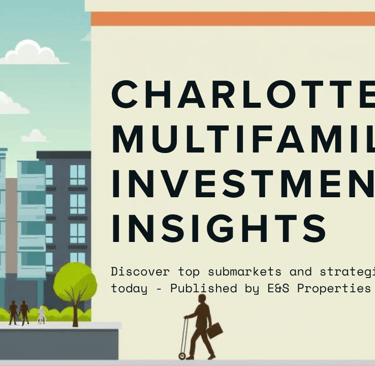Charlotte Multifamily: Where Supply Peaks and Value-Add Deals Emerge
Charlotte rents stabilize (+0.1% T3) as ~18k units deliver in 2025. Learn which submarkets and strategies favor investors now.
Published by E&S Properties
10/8/20257 min read


Charlotte Multifamily, August 2025: Stabilizing Rents, Record Supply, and a Window for Value-Add
Charlotte’s multifamily market is working through the heaviest delivery wave in its modern history—and holding up better than the headlines suggest. Trailing-three-month (T3) asking rents through June ticked up +0.1% to $1,594, while stabilized occupancy printed 93.8% in May. Both metrics trail national figures (U.S. rent: $1,749, occupancy: 94.6%), but the direction has improved since late 2024 as demand absorbs a very large slate of new product.
On the demand side, the regional economy remains a tailwind. Charlotte added 30,400 net jobs year-over-year through April, a +1.6% gain that outpaced the U.S. by roughly 80 bps; unemployment sat at 3.6% in May. Professional & business services led with +10,500 jobs, and long-horizon public–private investments like The Pearl Innovation District (a $1.5B research/education/health campus) underscore durable, knowledge-economy growth engines.
On the supply side, the headline is simple: Charlotte is delivering more apartments than at any time since at least 2017. Developers brought 8,337 units online in 1H25—3.5% of existing stock and 210 bps above the U.S. pace. Approximately 18,000 units are expected to deliver in 2025, a new cycle high. At mid-year, 30,847 units were still under construction (with another ~89,000 in planning/permitting), and starts have slowed to 3,602 units in 1H25 as capital tightened. The pipeline is skewed heavily toward Lifestyle (market-rate, higher-end) product—more than three-quarters of what’s underway—leaving a relative shortage of Renter-by-Necessity (RBN) on the other side of this wave.
Below we break down what’s moving the numbers—and how we’re positioning.
Rent & Occupancy: Signs of a Trough, Not a Collapse
After posting contractions in late 2024, Charlotte’s T3 rent growth is back in slightly positive territory. June’s +0.1% T3 print took average asking rent to $1,594, with Lifestyle at $1,691 (+0.1% T3) and RBN at $1,335 (−0.1% T3). This split is consistent with a market where concessions are most visible in lease-up corridors and among price-sensitive cohorts, while well-amenitized assets hold rate (or trade rate for occupancy) as supply crests.
Occupancy tells the same story. Stabilized occupancy stood at 93.8% in May—a notch below the national 94.6%—with Lifestyle ticking up +30 bps year-over-year to 93.8% and RBN down −60 bps year-over-year to 93.7%. Translation: absorption is happening, but the pace is gated by the record delivery calendar. Expect concessions to remain a feature through initial lease-ups in the heaviest submarkets.
Submarket Standouts: Gastonia & Kannapolis Buck the Trend
Rent performance is uneven across the metro, with more than half of 52 submarkets showing year-over-year contractions through June. Notably, Gastonia–North led year-over-year rent growth at +8.1% ($1,398), followed by Gastonia–South at +4.6% ($1,418) and Kannapolis at +4.2% ($1,606). The priciest submarket, Uptown, registered a −4.1% year-over-year decline to $2,141—unsurprising given a heavy concentration of new deliveries, elevated concessioning, and a resident base with more substitution options.
For operators and buyers, these splits point to a barbell: rent leadership on the suburban edges where new supply is thinner and household formation is steady, versus rental softness in core luxury nodes still digesting early-cycle starts.
Construction Map: Where the Pressure Will Be
Ten submarkets carry 1,000+ units under construction. Tryon Hills leads with 4,548 units underway, with Colonial Village–Montclaire (3,014) and North Charlotte (2,979) close behind. The single largest project in the metro, Seventh & Tryon (685 units) in Uptown, targets delivery in September 2026. These clusters represent both near-term competition and medium-term opportunity—lease-ups will set comps and reveal where stabilized concessions “burn off” first.
At the metro level, Charlotte still has 30,847 units under construction and ~89,000 units in planning/permitting. With 1H25 starts of 3,602 units vs 5,367 in 1H24, the “supply bulge” appears to be peaking; fewer late-cycle starts should translate to leaner deliveries from late-2026 onward, all else equal.
Capital Markets: Lighter Volume, Value-Add Tilt
Transaction activity remains subdued. Investors traded $494M of Charlotte multifamily in 1H25, down roughly a third year-over-year. Over the last two years, annual volume averaged nearly $2B, but the 10-year average is $2.8B—heavily boosted by 2021–2022’s outlier years. The deals that did print skewed toward workforce/value-add: RBN accounted for 7 of 13 trades through Q2. Average price per unit settled at $191,742 (vs a U.S. average around $212,317). Submarkets with the most dollar volume in the 12 months ending June: North Charlotte ($231M), Colonial Village–Montclaire ($226M), and Southwest Charlotte ($198M).
Taken together, this is a classic late-cycle setup: thinner bid/ask bridges, but selective trades where business plans hinge on operational improvement, targeted capex, and finishing delayed programmatic renovations.
Demand Drivers: Labor, Education, Health, and Labs
Charlotte’s demand story is broader than headline payrolls. Alongside financial services and logistics, growth is increasingly anchored by education/health and innovation nodes. The Pearl Innovation District’s first phase is now complete; upon full build-out (4.2M sf across lab/office/academic/retail), the district is expected to support ~5,500 on-site jobs over 15 years. This kind of multi-phase, university-adjacent investment can catalyze submarket stickiness: longer household tenures, higher propensity for roommate households, and steady graduate/professional inflows that support absorption in adjacent neighborhoods.
What the Numbers Mean for Operators
1) Lease-up risk is real—but finite. With ~18,000 units slated for delivery in 2025 on top of 8,337 already online in 1H25, some submarkets will feel crowded. Expect persistent concessions (especially in the urban core and high-amenity corridors) until absorption normalizes. The positive T3 rents suggest we’re closer to the trough than the peak of pain.
2) Workforce housing should outperform into the next phase. The pipeline’s >75% Lifestyle mix implies a relative shortage of RBN units in 2026–2028 once deliveries crest and slow. Operators with well-located, functionally competitive RBN assets will likely benefit from pent-up demand as price gaps widen again.
3) Portfolio tuning beats broad strokes. Submarket rent spreads are meaningful (e.g., Gastonia–North +8.1% vs Uptown −4.1%). Operators should concentrate marketing, renewal strategy, and concession spend where the elasticity is highest—and trim burn in nodes still adding thousands of units.
4) Labor remains a backstop. With unemployment at 3.6% and professional services still expanding, the job base is supportive even if national growth cools. That backdrop historically shortens the “flat period” post-delivery bulge.
Our Investor Playbook in Charlotte
Focus on basis, not blue-sky. In a market at $191.7k average PPU with lighter volumes, we are underwriting to get paid for near-term lease-up risk and execution. Assets with fixable friction (unit modernization gaps, energy/water inefficiency, amenity misalignment) are more attractive than stabilized yield plays that depend on short-term rent acceleration.
Favor submarkets with limited concurrent deliveries. We like Gastonia corridors and Kannapolis for their relative supply constraints and positive year-over-year rent prints. Conversely, we’re cautious in Uptown and heavy-construction nodes (Tryon Hills, Colonial Village–Montclaire, North Charlotte) until concessions abate and early-to-mid 2026 deliveries clear.
RBN-forward business plans. With the pipeline skewed to Lifestyle, we’re hunting RBN opportunities where modest interior upgrades, curb-appeal, and systems capex can widen the value gap versus new construction—capturing flight-to-value demand as peers push asking rents to cover higher carry.
Tighten assumptions. Near-term, we assume longer lease-up, sustained concessions in high-delivery submarkets, and conservative renewal spreads. We’ll revisit growth assumptions as the starts slowdown (3,602 in 1H25) pushes the next major delivery cohort farther right on the timeline.
Risk Check
Delivery timing risk. If construction backlogs clear faster than expected (labor/inspection bottlenecks ease), new-unit competition in 1H–2H26 could run hotter than modeled. That argues for basis discipline and flexible concession budgets.
Demand elasticity at the top end. Uptown’s −4.1% year-over-year rent print is a reminder that high-amenity renters can (and will) shop concessions across comparable communities. We avoid underwriting premium lift until effective rents show durable traction across multiple comps.
Financing frictions. Transaction volume ($494M in 1H25, down roughly a third) evidences a still-wide bid/ask and higher capital costs. Sponsors must be realistic on exit cap assumptions and debt structure (proceeds/IO periods) to prevent plan risk from turning into refi risk.
Near-Term Outlook (Next 12–18 Months)
We expect Charlotte to muddle-through 2H25 with generally flat to modestly positive T3 rent prints, pockets of negative year-over-year in supply-heavy nodes, and slow improvement in stabilized occupancy as 2025’s record deliveries are absorbed. By mid-to-late 2026, the deceleration in starts should translate to a thinner delivery pipeline and firmer fundamentals—particularly for well-located RBN assets that benefit from relative scarcity.
Demand should remain resilient given payroll growth ahead of the U.S., low unemployment, and the maturation of anchor projects like The Pearl. While we don’t underwrite a snapback, we do expect a “grind-higher” regime: flat/low-single-digit rent growth in 2025, moderating concessions into early 2026, and healthier effective rent growth thereafter as the supply bulge crests and burns off.
What We’re Watching
Lease-up velocity at the largest 2025–2026 communities (initial absorption pace, concession burn, renewal capture on early cohorts).
Rent-to-income ratios by submarket to calibrate headroom for effective rent moves as concessions retreat.
Transaction comps in RBN deals: are buyers being compensated (in basis and cap rate) for near-term stabilization risk vs. Lifestyle peers?
Job mix—especially professional & business services and education/health—as The Pearl ramps its ecosystem.
The Bottom Line
Charlotte remains one of the Southeast’s most investable metros, with a productive labor market, diversified economic base, and sustained in-migration. 2025’s record deliveries are the hurdle—not the thesis. Rents are stabilizing on a T3 basis, occupancy is edging higher off the lows, and starts have already slowed. For owners and acquirers willing to underwrite through the noise—prioritizing basis, durable submarket demand, and RBN-oriented business plans—the next 12–18 months should offer some of the cycle’s cleaner entries.
🔎 Ready to take the next step?
📩 Sign up for our newsletter to get weekly insights on current trends.
📝 Interested in investing? Complete our investor questionnaire and we’ll be in touch with opportunities that match your goals.
